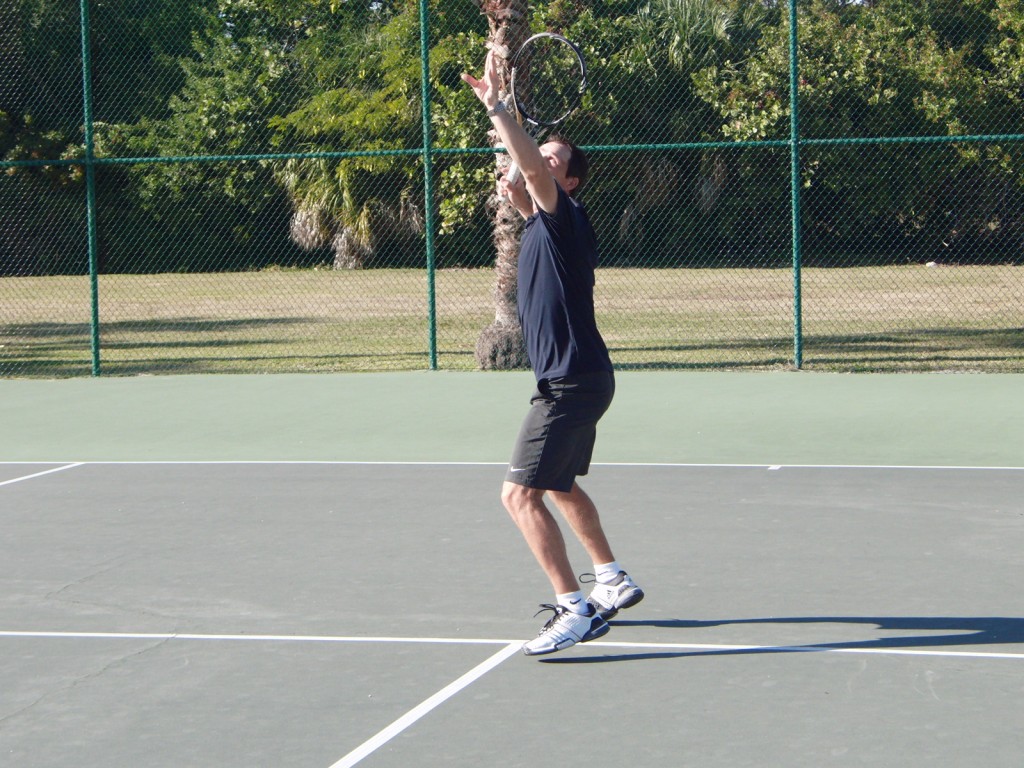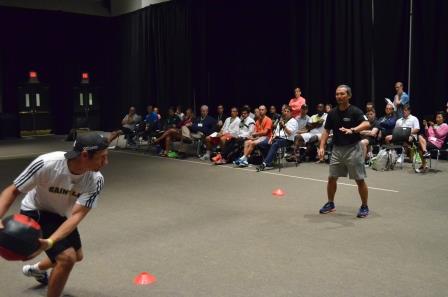MEMBER LOG IN
Categories
Links
Category Archives: Serve
A Biomechanical Analysis of Abdominal Injury in tennis serves; A Case Report. (Tubez et al, 2010).

The serve is arguably the most important stroke in tennis. Not only does one have more time to execute this stroke than any other stroke but one also has two attempts to get it in. Having said that, it is equally important to use correct technique in this stroke so as to ensure efficiency and quality in movement (not to mention avoid injury).
In a study by Tubez et al, 2015 titled “A Biomechanical Analysis of Abdominal Injury in Tennis Serves; A Case Report”, the focus was on an ATP professionally ranked tennis player who had sustained an injury after serving. The goal of the study was to understand if the injury sustained could be explained by the players incorrect serving technique.
Previous studies in this area have shown that abdominal muscle disorder could be a source of potential risk for local injury in tennis (Natis et al 2012: Sanchis- Moyis et al, 2010) but it has not yet been shown that a specific serve kinematic could cause an injury to the abdominal muscles during this stroke. The aim of this study was to prove that a flaw in technique could cause an abdominal injury by way of comparing a biomechanical evaluation of the player to that of a control group.
The injured player was compared to five other professional tennis players of similar attributes in a series of measurements to examine possible differences.
Measurements consisted of a) 25 serves into the “T area” of the court
b) a 3D measurement of players movement patterns during the service motion. c) measuring maximal external rotation of the shoulder joint as well as maximal rotation of the pelvis and trunk using 3D kinematic evaluation.
d) measuring players maximal ground reaction force and impulsion using two force plates.
e) measuring passive joint mobilisation of the main joints and muscle flexibility, as well as measuring the isokinetic force generated by the hamstrings and quadriceps.
The study found that injured player had the best serving performance in racket speed compared to the mean of the group which could be significant because there is a correlation between racket velocity at impact and ball speed (Gordan and Dapnena, 2006).
The author also states that leg extension is a key parameter in the search for efficiency in the tennis serve and therefore rapid leg extension contributes to serve speed. In relation to this the injured player had a lower leg drive impulsion result. However, this was not due to a deficit of strength as isokinetic results showed better muscle quality in the injured player than that of the mean of the group.
Results showed that ankle plantar flexion bi-laterally was lower for the player than the group. Also, when leaving the force plates the player was shown to have more knee flexion bi-laterally than the control group and therefore incomplete knee extension when leaving the force plate. The author thus hypothesises that this lack of energy generation must therefore be recovered by other movements in the kinetic chain in order to obtain the best result of serve velocity.
Additionally, an anterior pelvic tilt was measured as higher for the injured player than those in the control group, which is of significance because this causes increased lumbar lordosis leading to tension on the hamstrings which the author reasons as an explanation for the players incomplete leg drive.
A maximal forward shoulder velocity was shown to be higher for the player than in the group during serve indicating a higher energy generation between pelvis and shoulder for this player highlighting a compensation between pelvis and shoulder. The author reasons that the abdominals are then working harder to transfer energy from the pelvic girdle to the shoulder girdle.
Results also showed a larger external rotation for the player than in control group which is significant in the cocking phase of the service motion as the player takes his racket back. The authors states that this action could also add increased lumbar lordosis in addition to the abdominal eccentric tension. That author hypothesises that the players lack of leg drive leads to various compensations including abdominal workload and larger external shoulder rotation.
The eccentric contraction of non-dominant rectus abdominus followed by a concentric contraction during the cocking phase of the service motion is then hypothesised as related to the injury mechanism. The anterior pelvic tilt also develops an abdominal pre-stretch during the eccentric phase of serve followed by a concentric phase of the abdominal contraction. In a previous study by Maquiriian et al, 2007 it is stated that this rapid muscle request during the start of trunk flexion can lead to tear, as could be the case here.
Regarding this study, the author admits that overuse could be one reason for injury as well as imperfect technique.The injured player was shown to have a deficit of energy transfer due to an uncompleted leg drive and a specific pelvis kinematic which led the author to propose that the player compensated. The author states that the injured player may have compensated by way of a larger abdominus contraction. These specificities could be a retrospective explanation of medical history concerning the players abdominal muscles as well as the players risk for future injury.
What must not be overlooked was that the injured players serve was faster than those in the control group despite the deficiencies outlined in the results of testing. However, as stated results indicate that the specific technique of serve has been compensated for by the injured players lack of ROM, lack of ankle plantar flexion, lack of knee extension, increased anterior pelvic tilt and increased external rotation in the shoulder.
Some practical applications can be offered in the management of players through a 3D analysis thanks to this study such as measuring ankle ROM, GHJ ROM and Knee ROM. Also, this study shows that when training athletes to prevent injury during the serve it is important to work on ROM and ensure that the kinetic chain is firing optimally.
Bjorn Blythe provided the critical review and summary of these research studies.
How Many Serves Should Junior Tennis Players Hit Per Day, Per Week, Per Year During Development: A Discussion
One of the questions that come up at many coaching conferences and in the strength and conditioning, physical therapy, athletic training and medical communities is related to what is an appropriate recommendation for the amount of serves a junior tennis player should hit per day or per week. Much interest is related Continue reading
Posted in Serve
3 Comments
Presentation Slides From Performance Lectures at 2014 Tennis Medicine & Performance Conference
On July 19th and 20th, 2014 the iTPA and STMS combined to host the 2014 Tennis Medicine & Performance Conference in Atlanta, Georgia (USA). This great 2 day education event brought together experts in all aspects of tennis medicine, science, performance training and coaching. As many of the iTPA family could not attend in person we are providing some resources for our members in over 24 countries. In this post you will see a selection of the performance focused presentation slides.
If you are interested in viewing 10 of the most well-attended sessions during the conference, please visit the link below with the ability to subscribe to over 7 hours of video from the conference 2014 Tennis Medicine & Performance Conference Videos
Todd Martin and Mark Kovacs Tennis Serve Tips: Video
View this video clip from Todd Martin and Dr. Mark Kovacs discussing the serve. This is taken from the Drills and Exercises to Improve the Tennis Serve DVD, now available for purchase at http://www.itpa-tennis.org/dvds.html. Continue reading
Posted in Dr. Mark Kovacs, Serve, Todd Martin, Video
Leave a comment
iTPA Tennis Stroke Mechanics and Injury Prevention Dec 2012 Seminar: Video
This 1 hour 30 minute seminar video provides the latest information on how to analyze tennis technique to improve performance and limit the likelihood of injury. Continue reading
2012 STMS/USTA Tennis Medicine & Injury Prev Conference Summary: Dr. Ben Kibler Tennis Serve Statistics
Some Basic Serve Statistics From The ATP and WTA Tour
Tennis serve statistics can provide some very valuable information about the tennis athlete. Every level of the game serve statistics will be different based on the level of athlete, style of play and gender. However, much can be learned from analyzing the data. Continue reading
Posted in Conference Summary, Dr. Ben Kibler, Serve, Sports Science
Leave a comment
New Article: 8 Stage Analysis of Federer’s Serve
The iTPA has been fortunate to write several articles for Tennis India Magazine. This one analyzes the 8 stages of Roger Federer’s Serve. Continue reading
Posted in Article, Serve
Leave a comment
2 New Hour Long Videos Available Free for Members Only: Breaking Down the Serve (8 Stages) and Common Tennis Problems & Drills to Improve
Two new videos posted to ITPA.TV that are available FREE only to iTPA Members (normally cost $9.99 for non-members). These videos are both filmed live presentations featuring iTPA Executive Director Dr. Mark Kovacs and are about an hour long each. As our Dartfish system and links have recently changed, to gain access to these videos please email maryjo@itpa-tennis.org and we will email you access from our system!
Posted in Dr. Mark Kovacs, Movement, Performance, Serve, Tennis Strokes, Video
Leave a comment

